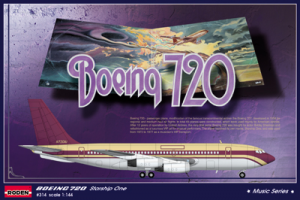
At the beginning of the 1950's the Boeing company created one of the greatest planes of the Twentieth Century - the Boeing 707, which undoubtedly initiated the era of passenger jet travel for the masses. In 1957, the company's management decided to modify the aircraft for possible use on medium-range routes and on runways of shorter length.
Thus the Boeing 720 was developed, which in comparison with its predecessor was slightly shorter (the fuselage was reduced by 2.45m) and had a redesigned wing and in general was more straightforward to operate than the Boeing 707. Pratt & Whitney JT3C-7 engines were installed in the airplane. On November 23, 1959 its first flight took place, and 65 were constructed. A year later a more advanced modification was developed, the Boeing 720B, with JT3D engines. The principal operators of the Boeing 720 were US airlines, although a small number was sold to Germany, Israel, Pakistan, Ireland and some other countries.
The history of the operation of the Boeing 720 as a passenger plane was mostly unexceptional, as most other airliners, but at least one machine out of the relatively small number built, left behind some special memories - not just in aviation history but in the history of the rock music of the Twentieth Century. This machine with the serial number N7201U was delivered to United Airlines and was used by it on internal routes from 1960 to 1973.
In 1973 famous former American actor and singer Bobby Sherman together with his manager Ward Sylvester, co-owners of artists agency Contemporary Entertainment, purchased the plane from United Airlines with the intent of converting it into a convenient and comfortable 'flying hotel' for effecting flights between cities and out of the country by various artists. The music industry during this period was at its peak - a considerable number of performers of all styles of music plied their trade on numerous tours of the territory of the USA, and without any particular financial drawbacks the considerable fees received by them for concerts at that time allowed them to rent the plane for fast and comfortable travel from city to city.
The well-known band Led Zeppelin was the first of many acts who fully appreciated the advantages of such VIP accommodation. Their manager Peter Grant never held back over issues connected with comfort for the members of the group, and so for Zeppelin's tours, which often covered some tens of cities of the USA during the season, Starship One was a real find.
In 1974 Starship One was hired by another famous 20th Century rock group, Deep Purple. At this time Deep Purple were at a critical stage of their career - vocalist Ian Gillan and bass guitarist Roger Glover had just left the group, but they were replaced by David Coverdale and Glenn Hughes. With this new line-up in 1974 (known as 'Mark III') Deep Purple arrived in the USA, where the California Jam Rock festival was to take place.
The festival was unsuccessful and didn't justify the hopes of the organizers, and Deep Purple returned to the UK aboard Starship One, but in the following year during the next tour they rented the same plane again. At that moment the group finally lost one of its founders, its leader and guitarist Ritchie Blackmore. He was replaced by Tommy Bolin, and in the new line-up, known as Deep Purple Mark IV, they went on a world tour. It should be noted that the plane's color scheme was unaltered, but instead of the Led Zeppelin emblem, 'Deep Purple' was emblazoned on the fuselage. However, the destiny of Deep Purple Mark IV was more connected with scandals, than with worldwide fame - in 1976 Tommy Bolin died of a drug overdose, and Glenn Hughes was several times arrested by police for the same offense. Deep Purple ceased to exist after that.
